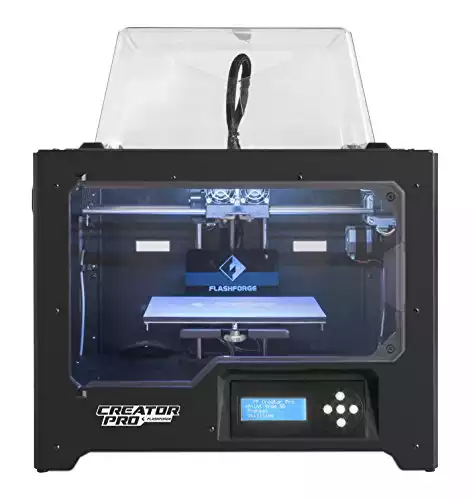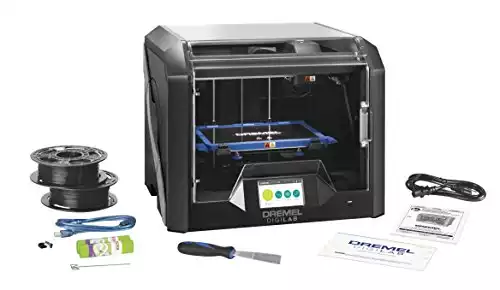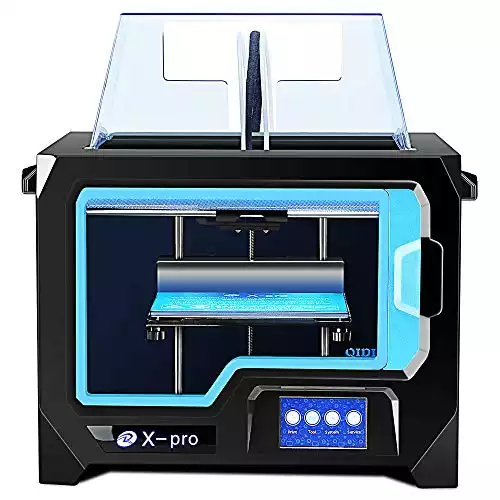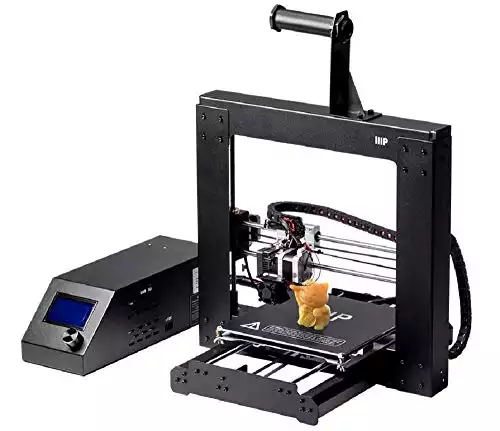- Flashforge Creator 3 Review [2022]: Our Honest Opinion - April 5, 2022
- Anycubic Photon Review [2022]: Will This Work for You? - April 5, 2022
- X-Carve Review [2020]: Is This CNC Machine Right For You? - April 4, 2022
Most flexible filaments are referred to as TPE or TPU. They have elastic properties that create a final product that’s stretchy. The great thing about flexible filament is that it’s resistant to fatigue, it’s soft, and a heated bed isn’t required for printing.
However, there are some things you need to consider when looking for a 3D printer to use with flexible filament.
Table of Contents
Up Front Summary
- FlashForge Creator Pro: Best Overall
- Dremel 3D45: Luxurious Option
- QIDI-Tech X-Pro: Easy to Set up and Use Option
- Monoprice Maker Select Plus: Large Volume Print Option
- Tevo Tornado: Budget-Friendly Option
Aviation level aluminum plate with a thickness of 6.3mm guarantee its surface is completely flat and will not warp during heating process.
Best Printers for Flexible Filament
3D printers with direct-drive extruders are the best options for printing with flexible filament. There are plenty of options on the market, but here are some of the best.
1. FlashForge Creator Pro
FlashForge makes some of the best printers for beginners that you can buy. They’re great for the classroom as well. The FlashForge Creator Pro isn’t the top of the line, but for the moderate price tag, you’re getting a workhorse of a 3D printer.
It has a metal frame, acrylic covers, dual extruder with two spools, and an optimized build platform. It also works with ABS and PLA. This direct drive 3D printer delivers a lot for the price.
The Creator Pro is reliable and long-lasting. It’s built on an open-source platform, so it’s easy to adjust and customize to make it your own. This is one of the reasons it works so well with flexible filament. You can adjust all of the settings to create an optimal printing environment.
The metal platform can withstand high print bed temperatures and also offer a sturdy platform for more stability during vertical movement. It’s also sturdy enough to reduce wobbling during printing.
The powder-coated steel frame backbone holds the mechanisms for motion in place during printing to make it faster and more precise when you’re not using flexible filament. This versatility makes it an ideal solution for those who want to print using other materials.
The downside to the Creator Pro is that it has a closed unit, which reduces the print volume. However, it does help to maintain consistent temperatures and it offers more safety for younger printers, beginners, or in a classroom setting.
Setup is a cinch because it comes fully assembled. The front door opens to almost 180 degrees, giving you full access to your completed job so you can remove it easily when it’s done. While it’s not a touch screen, it does have Wi-Fi, so you can connect your mobile device via the smartphone app and monitor your jobs.
FlashForge Creator Pro makes some of the best printers for beginners that you can buy. For the moderate price tag, you’re getting a workhorse of a 3D printer.
Features:
- Nozzle: 0.4mm
- Filament: 1.75mm
- Print volume: 200mm x 145mm x 150mm
- UI: Button controls
- Wi-Fi enabled
- Heated bed
- Max print speed: 100mm/s
Pros:
- Affordable
- Fast and accurate
- 3-point leveling system
- An open-source platform for extra customization
Cons:
- No touchscreen
- Small build volume
Further Read:
2. Dremel 3D45
This award-winning 3D printer comes with a heated build plate, connections to all of your smart devices, Wi-Fi, a built-in HD camera, and compatibility with ECO ABS, PLA, PETG, and Nylon filament types. While you’ll never find a 3D printer that’s good at everything, this one comes close. Its impressive list of features makes it appealing to a wide range of users and helps it stand out among its competition.
It’s a more expensive solution, but for many, the easy setup, reliability, consistency, and high-quality finished prints will make up for that. The closed frame controls print jobs in a regulated environment and keeps users safe. Two plastic doors that open outward give easy access to the print area. The doors are clear, helping you monitor your jobs with ease.
The large print volume will accommodate most jobs and the huge 5-inch touchscreen is intuitive and easy to understand.
One problem you may run into is that Dremel only supports their own filament, so if you do use another brand and run into trouble, you won’t find help from the manufacturer. However, it’s fully capable of printing with third party materials, and people familiar with 3D printing shouldn’t have a problem.
Dremel also only offers a limited range of colors, so if you want more than the 10 they offer, you’ll have to look elsewhere. Loading filament is straightforward and the direct drive extruder eliminates some of the problems you might have with flexible solutions.
With connections like Wi-Fi, Ethernet, or USB, you can print from almost anywhere. There’s also a printing app so you can use your phone to slice files, send prints, and monitor progress, thanks to the built-in camera.
One of the cool things about this printer is that after your build is done, it creates a time-lapse video of the whole job so you can download and view it.
The latest and greatest new 3D printer from the geniuses at Dremel, the DigiLab 3D45 is a workhorse that's perfect for household projects, education, or use in a print farm. An all-metal hotend, a heated bed, and a super quick and easy set-up through the powerful touchscreen make this the most capable Dremel printer yet!
Features:
- Nozzle: 0.4mm
- Filament: 1.75mm
- Print volume: 255mm x 155mm x 170mm
- UI: 5-inch full-color IPS touchscreen
- Wi-Fi
- Smartphone app
- Heated bed
- Max print speed: 100mm/s
Pros:
- Easy to set up and use
- Great print quality
- Semi-automatic bed leveling
- Automatic filament detection
- Smartphone app
Cons:
- Expensive
- Doesn’t support third-party filaments
3. QIDI-Tech X-Pro
QIDI Tech produces a line of quality 3D printers that many experienced users love. The X-Pro is labeled as a commercial printer with Wi-Fi, dual extruder, and high precision double color printing with ABS, PLA, and TPU filament.
At its moderate price point, it’s an affordable, industrial-strength 3D printer. The enclosed design makes it ideal for temperature-sensitive ABS filament and ensures the safety of beginners.
With a large clear door, you can still easily monitor your job while maintaining a controlled environment. Plastic and metal construction gives this machine a premium look.
The stylish design is shipped almost fully assembled. A small amount of setup will have you up and running in no time.
The direct drive extruder and heated aluminum build plate make this product ideal for flexible filament because it can solve many of your common problems. From jamming to slipping on the print bed, many of your challenges will be alleviated.
You’ll find that the build volume is much larger than the Creator Pro but still smaller than the Monoprice Maker Select Pro. An LCD touchscreen makes it easy to interact with the printer and the build plate can be removed completely to access your completed job.
Useful for consumers and schools, easy to set up and use, does not require a lot of maintenance, and has reasonably good print quality.
Features:
- Nozzle: 0.4mm
- Filament: 1.75mm
- Print volume: 230mm x 150mm x 150mm
- UI: LCD touchscreen
- Wi-Fi
- Max bed temperature: 110 degrees Celsius
- Max nozzle temperature: 250 degrees Celsius
- Max print speed: 150mm/s
Pros:
- Removable build plate
- Dual extruder for multi-color jobs
- Durable construction and premium design
- Large LCD touchscreen
Cons:
- Noisy fans
- Wi-Fi can be unreliable
4. Monoprice Maker Select Plus
The large heated bed, LCD touchscreen, and MicroSD card loaded with printable models make this a worthwhile purchase. The direct drive extruder moves along X and Z axes and it shares a lot of features with other popular 3D printers but at a super affordable price.
With the Monoprice Maker Select Plus, you’ll get a bigger print volume than the Creator Pro at a fraction of the cost, and it also has a smaller footprint, thanks to the control box integrated beneath the print bed. Even if you have a limited workspace, you can still take advantage of a large print volume for your flexible filament products.
The convenient touchscreen in the front makes it easy to control the print settings and a USB connection means you can print even when your computer is offline. While the open design doesn’t make this printer ideal for ABS, you can still print with a wide variety of filaments, including the most flexible ones.
You can use your own designs with this one, but it also comes with a MicroSD card loaded with 3D print designs that you can use for practice, making it a good, affordable purchase for beginners.
Further Read: Monoprice Maker Select Plus Review.
The large 8 x 8 inches build plate and generous 7 inches vertical spacing means that you can print larger, more complex models.
Features:
- Nozzle: 0.4mm brass
- Filament: 1.75mm
- Print volume: 200mm x 200mm x 180mm
- UI: 3.25-inch touchscreen
- Wi-Fi
- Heated bed
- Max print speed: 150mm/s
Pros:
- Affordable
- User-friendly touchscreen
- Wi-Fi
- USB enabled
Cons:
- Not ideal for ABS
- No auto-leveling mechanism
5. Tevo Tornado
This is another great option for flexible filament 3D printing, particularly if you are in the market for a BUDGET 3D printer.
Bowden style Titan Extruder with improved hotend design. Fast heating silicone hotbed and 95% assembled, easy for installation.
Further Read: Tevo Tornado Review.
Overview of Flexible Filament
Thermoplastic Elastomers, or TPE, are a material made from a blend of rubber and hard plastic. It’s an elastic material that allows the plastic to be stretched. While there are several different types of TPE, Thermoplastic polyurethane, or TPU, is the most common.
A lot of times you’ll see these two names used interchangeably. The brand name Ninjaflex also falls into this category and is used commonly to describe flexible filament, even though it may be a different brand.
How much the material stretches depends on the chemical composition chosen by the manufacturer. While some filaments are somewhat flexible, like the rubber used to make car tires, other types can be fully elastic, like a rubber band.
Pros:
- Impact resistance
- Long life
- Great vibration dampening
- Soft and flexible
Cons:
- Doesn’t work well with Bowden extruders
- Can blob or string
- Doesn’t bridge well
- Difficult to print
Types of Flexible Filament
Before printing, it’s important to understand the types of flexible filament available to you. There are many, but here’s a quick overview of some of the most common types.
NinjaFlex
NinjaFlex TPE is soft but very strong. The low-friction exterior helps to speed up printing without causing a lot of buckling. Users online give it good reviews, but there have been some problems feeding. A low heat bed is best for this type of filament.
The makers of NinjaFlex also make SemiFlex, which you may have guessed based on the name is only semi-flexible and not as soft as the NinjaFlex.
Truly flexible - no fill or layer manipulation required to achieve performance. 660% elongation allows for repeated movement & impact without wear or cracking. Excellent vibration reduction.
FlexSolid
This product made by MadeSolid has good elasticity but is still very strong. If your final product needs to be highly durable, this is a great choice. It works for mechanical items and sporting equipment.
It’s best used in simple designs. Intricate details may come out stringy using this type of filament. If you keep it simple, it’s relatively easy to print with compared to others.
FlexSolid is the latest innovation from MadeSolid. FlexSolid is an extremely flexible yet resilient filament which does not tear easily like many flexible filaments. FlexSolid is ideal for creating engineering grade parts that need elasticity and durability.
FlexiFil
FlexiFil is still very strong and soft, but not as soft as NinjaFlex. It’s a TPC (Thermoplastic Co-Polyester) material, so it’s incredibly flexible. It’s also resistant to high temperatures and environmentally friendly.
It’s made from renewable carbon content, which makes it a great responsible solution, but it can get clogged in the extruder easily.
FlexiFil has unique flexural strength properties, as 3D printed objects with FlexiFil will have a “flexural memory”, allowing objects to return back to their original position or shape after being bent, dent, or folded.
Fila Flex
This type of TPE is made from the same materials as NinjaFlex, so it has similar properties, but it’s not as strong. It’s really soft and because it’s highly adhesive, the layers of your job will stick together well.
It’s more elastic than NinjaFlex and is great for final products that need a lot of stretches. However, that also makes it very hard to print with. Because it’s soft, it can come out stringy and it can clog the nozzle. It can be printed on a cold bed rather than a heated one.
3D printing with flexible materials can really expand the capabilities of any project. Materials like MatterHackers PRO Series Flex, NinjaTek, or Soft PLA all behave similarly to rubber, which makes it perfect for printing things like gaskets, stoppers, or even phone cases.
Makerbot
This polyester-based filament is more firm than FlexiFil and NinjaFlex. With a lower melting point, it’s a lot easier to extrude. The cool thing about Makerbot’s flexible filament is that you can run it under hot water to reshape it.
It has a glossy, iridescent finish, but you may have some trouble with tangling while feeding.
MakerBot PLA Filament is the highest quality PLA 3D printing material available. Save time and money when your order this 10-Pack, and get 1 of each of the following rich MakerBot.
Further Read: Makerbot 3D Printers.
Flexible Resin
This type of filament only works with SLA 3D printers. The good thing about it is that SLA doesn’t use a feeding system, so you won’t encounter the same challenges that other flexible filaments do.
If you have an SLA 3D printer, this material is great for tactile designs. Watch bands, stamps, grips, and other things you touch frequently are great projects for this type.
Flexible 3D printer resins that are capable of bending, twisting, and maintaining their original shape. Expand your SLA Laser and DLP 3D printing with flexible 3D printer resins.
See the best flexible resins and 3D Printers here:
Challenges of Printing
As with any technology, printing with flexible filament can be very useful, but it does come with some challenges.
Feeding
Because the flexible filament is so soft, it can be difficult to feed through the extruder. It can jam, clump, and string. When feeding the filament through to the hot end of the extruder, it needs a direct path so it doesn’t get deformed and stuck.
Buckling
If you print too quickly with flexible filament, it tends to buckle when it gets pushed through the hot end of the extruder. It can also happen if you don’t have a tight or narrow enough pathway from the extruder to the hot end.
Buckling is pretty annoying and can ruin the whole job. It can also cause jams, which means you have to stop the whole job to clean the extruder.
Difficulty sticking
Sometimes you’ll encounter shrinkage or your print job won’t stick to the bed, causing problems with slipping. It may require adjusting the print bed temperature, but often it can be solved with just a bit of hairspray or painter’s tape.
Stringing
When pressure builds up in the extruder, it can release extra filament and create a messy or a stringy print. This happens more often with flexible filament than other types. It can be caused by speed, temperature, or retraction settings.
Tips
If you’re going to print with flexible filament, here are some tips for ensuring a successful job without any problems.
Print slowly
It’s recommended that you print with flexible filament between 30mm and 40mm per second. Every manufacturer will have different recommendations. FlexiFil recommends you print with their filament at 10mm to 20mm per second.
You could set your print speed as low as 5mm per second if you want more precision. It’s slow, but it will increase your chances of a perfect finished product because it helps to avoid pressure build-up in the extruder, which we already know leads to buckle and messy prints.
Use direct drive extruders
If you want to avoid jamming at the extruder, the best thing you can do is give your filament a direct path from the cold end to the hot end. Many people love Bowden extruders, but they aren’t ideal for flexible filament. It’s not impossible, but it does make it challenging.
If you need some quick tips on how to print flexible filament with a Bowden extruder, this video is pretty great.
Set the ideal temperature
You want your flexible filament to flow easily through the nozzle without buckling, getting jammed, or creating a messy print. However, heating up your extruder too much can cause stringing, oozing, or uneven prints.
While every printer is different and will require some slight adjustments, it’s always best to check on the material, which are the recommended temperatures for use.
Adjust your retraction settings
Retraction relieves pressure from the hot end of the extruder and keeps your filament from oozing through the nozzle when you’re not printing. You can adjust these settings based on your specific problem.
If it’s clogging, you may need a lower retraction setting. You may even try setting it at zero. You want the lowest retraction setting you can get away with to avoid stringing.
Adjust bed temperature and use tape
While you can use hairspray on your print bed to avoid slipping, usually adjusting the bed temperature and using painter’s tape works better. Temperature settings vary depending on the type of filament you’re using, but most flexible filament manufacturers recommend temperatures of 113-140 degrees Fahrenheit.
Flexible filament sticks well to blue painter’s tape, so lining your print bed with some blue painter’s tape can help with slipping, which creates an uneven print job.
FAQs About 3D Printing Materials
What is the most flexible 3D printing material?
While it can be confusing because there are many different brand names, thermoplastic polyurethane, or TPU, is the most commonly used flexible filament. There are many manufacturers who make TPU, so whether you’re buying a brand name product or not, if you’re looking for something very flexible, make sure it’s TPU.
What is the strongest 3D filament?
If you want a printer that’s versatile enough to print with several different types of filament, you may want to look into using polycarbonate. It’s the strongest material used for 3D printing, surpassing even nylon.
It’s the best choice for high-strength components if you don’t need them to be flexible.
How do I print with flexible filaments?
It can be tricky to print with flexible filaments, especially if you’ve just started experimenting with a 3D printer. PLA is the most forgiving and is a great place to start. However, if you need to print something with flexible filament, check out this guide.
Can Ender 3 print flexible filament?
Yes, Ender 3 has a direct drive extruder ideal for printing with flexible filament. There are several others besides what is reviewed here. You can check out the JGAURORA A8 for an extremely large print volume, the Original Prusa i3 for incredibly slow print speeds, ideal for printing with flexible filament.
The Verdict: Finding the Right Flexible Filament 3D Printer
If you’re looking for 3D printers ideal for printing with flexible filament, you’ll want to pay attention to a lot of different things. Specifications like slow print speeds and direct drive extruders are important.
You also want to make sure you have complete control over your retraction and can adjust every aspect of the job for optimal performance. Other considerations you might want to make are features like Wi-Fi, print volume, smartphone apps, and touchscreen UIs.
All of these 3D printers are fantastic, but there are many others. Choose the right one for you based on the specifications you need for the jobs you plan to print.
Aviation level aluminum plate with a thickness of 6.3mm guarantee its surface is completely flat and will not warp during heating process.

![How to Find the Best 3D Printer for Flexible Filament [2022]](https://total3dprinting.org/wp-content/uploads/2020/06/image-1-3.jpg.webp)


















